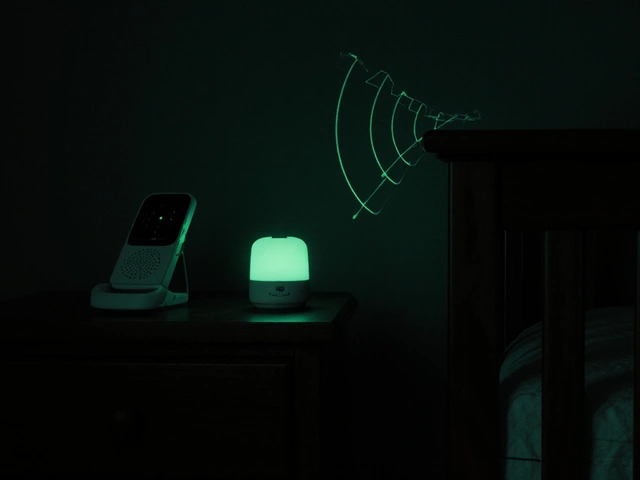Wearable baby monitors are popping up in nurseries everywhere, promising to put worried parents at ease. These tiny gadgets, often cozying up against a baby's skin, promise to track everything from heart rate to sleep patterns. But with all their claims, are they truly safe?
First, it's crucial to understand how these monitors work. Most of them use sensors to collect data from your baby's body, and then send that data to your smartphone. This technology can be a lifesaver, giving parents real-time updates that were once unimaginable.
However, with great tech comes great responsibility—and a fair share of questions. Are these devices emitting harmful radiation? Could they be interfering with your baby's natural development? These concerns are valid and need addressing if we're to embrace this wave of baby-monitoring tech.
- Introduction to Wearable Baby Monitors
- How Wearable Baby Monitors Work
- Benefits of Using Wearable Monitors
- Potential Safety Concerns
- Expert Tips for Safe Usage
- Final Thoughts on Monitor Use
Introduction to Wearable Baby Monitors
Technology has changed how we care for our little ones, and wearable baby monitors are at the forefront of this shift. From smart socks to sensor clips, these devices offer a whole new way of keeping tabs on your baby's health and sleep patterns. With real-time updates sent to your phone, parents can feel more connected and reassured.
Wearable monitors hit the market to address a modern parent's desire for more control over their baby's well-being. They're designed to track essential metrics like heart rate, oxygen levels, and even sleeping positions. This kind of data can help recognize patterns or potential issues early on, which is super helpful for peace of mind.
Getting Tech-Savvy in the Nursery
Most wearable baby monitors are easy to use. They typically involve a small sensor that attaches to your baby’s clothing or wraps snugly around their foot. The device syncs with an app on your phone, giving you updates anytime and anywhere. This hands-on approach empowers parents to stay informed without having to hover over their baby's crib.
The Surge in Popularity
Over recent years, there's been a noticeable rise in wearable monitor use. According to a 2023 survey, about 45% of new parents had used some form of smart baby monitoring device within the first year of their baby's life. This trend shows that as long as concerns about safety and effectiveness are addressed, these gadgets are here to stay.
But why have they become so popular? The main reason is their convenience and the wealth of information they offer. Instead of relying solely on intuition or sporadic check-ins, parents now have a more scientific approach to understanding their baby's habits and health.
How Wearable Baby Monitors Work
Wearable baby monitors are pretty neat! They take monitoring to a whole new level by collecting data directly from your baby’s body. These gadgets are usually small and designed to be comfy for your little one. They often come in the form of socks, wristbands, or onesies, ensuring they won’t get in the way during all that rolling and crawling.
So, how do these monitors actually do their thing? Well, most of them use small sensors to measure vital stats like heart rate and oxygen levels. They send this data over to your smartphone via Bluetooth or Wi-Fi. This means you can keep tabs on your baby's wellbeing in real-time.
Sensors Behind The Magic
Let’s break it down a bit. The sensors involved are quite similar to those used in fitness trackers. They’re designed to be non-invasive and super sensitive. Instead of sticking monitors on hospital walls, these are pressed gently against your baby’s skin, giving constant feedback about their health.
Connectivity: The Backbone of Monitoring
Connectivity is key here. Without it, all that juicy data wouldn’t make it to your phone. Most wearable baby monitors sync with an app that records data continuously. The cool part is, many of these apps alert you if something seems off, so you don’t have to stare at your phone every second.
If you’re wondering whether all this tech is reliable, you’re not alone. Some parents have reservations about how accurate these readings are. Generally, they perform quite well, but it's important to remember they shouldn't replace professional medical equipment.
Data Handling and Privacy
Another thing to consider is data security. After all, you’re dealing with personal information here. Reputable brands usually encrypt data to protect your privacy. It’s always a good idea to read the privacy policy before diving in.
Overall, these devices represent an evolving trend in baby care. They're designed to give parents peace of mind, even if it's just to help them focus more on those precious moments than constant worrying.
Benefits of Using Wearable Monitors
There's no denying that wearable baby monitors can be a game-changer for parents. One of the biggest bonuses? They offer peace of mind, letting you keep an eagle eye on your baby's vitals without standing over the crib 24/7.
Constant Monitoring
These devices provide continuous monitoring of your baby's heart rate and oxygen levels. Pretty nifty, right? Many products send notifications to your smartphone when there's a dip or spike, letting you react quickly if something seems off.
Better Sleep Insights
Ever wonder why your baby isn't sleeping through the night? Some wearable baby monitors track sleep patterns. By comparing nights over time, parents can spot trends and adjust the bedtime routine to help everyone catch those coveted Zs.
Easy to Use
The setup is often straightforward. Most monitors are designed with busy parents in mind. Pop them on a baby's ankle or wrist, sync them to an app, and you're good to go. It's tech that's designed to be as seamless as possible.
Freedom for Parents
Got to run to the grocery store or take a toddler to daycare? Wearables let you leave the room or even the house (if you've got a sitter) with more confidence. You can get updates while you're out and about.
| Feature | Benefits |
|---|---|
| Real-Time Alerts | Immediate notifications on vital changes |
| Data Tracking | See long-term trends in health and sleep |
| User-Friendly | Quick setup, easy monitoring via apps |
Overall, baby monitor safety is at the forefront, and these wearables are built with that in mind, giving parents one less thing to worry about in the chaotic world of parenting.

Potential Safety Concerns
You've probably heard a lot about wearable baby monitors, but before strapping one onto your little champ, let's talk about some real-world concerns. People often worry about the technology behind these devices and its impact on baby health.
Radiation and EMF Exposure
One big question mark hovering over wearable baby monitors is radiation. These devices often use Bluetooth or Wi-Fi to send data, which means they emit electromagnetic fields (EMFs). It's normally low-level, but it's still something to think about. While there's no solid evidence linking these EMFs to serious health problems, some parents feel uneasy. So, it might be worth exploring monitors that use low-energy Bluetooth to ease those concerns.
Skin Sensitivity and Allergies
Monitors usually sit directly on a baby's skin. If your baby has sensitive skin, there's a chance of irritation or an allergic reaction. The materials used typically pass safety standards, but no one likes surprises, right? Always check for hypoallergenic bands or patches—it's just one less thing to worry about.
Data Security Issues
Here's a modern-day twist on baby monitoring—data security! The fact is, these devices collect a stack of personal information, and if the app or the manufacturer's server isn't secure, this data can be at risk. Ensure that the monitor has robust security features like encryption, making it less likely for data breaches.
| Concern | Notes |
|---|---|
| Radiation | Low-level, often from Bluetooth |
| Skin Sensitivity | Irritations possible, choose hypoallergenic options |
| Data Security | Look for encryption and security features |
Before jumping in, ask yourself if the benefits outweigh these potential concerns for your family. Looking for safety certifications and reading reviews are simple but effective steps to ensure you're getting a reliable product. Remember, it's always okay to be cautious when it comes to your baby's wellbeing.
Expert Tips for Safe Usage
Wearable baby monitors can be a helpful tool for parents, but it’s essential to use them wisely. Here are some tips from experts to ensure you're getting all the benefits without the potential downsides.
1. Choose the Right Device
Not all wearable baby monitors are created equal. Look for models that have been tested by pediatricians and possess well-documented safety standards. Reading up on reviews and consumer feedback can also be immensely helpful.
2. Limit Usage Time
While it may be tempting to keep your baby wired up all the time, experts suggest limiting monitor usage to when your baby is sleeping or during specific times you want to track health metrics. This reduces prolonged exposure to the device.
3. Follow the Manufacturer's Instructions
Every device comes with its own set of instructions for safe usage. Stick to them closely to avoid any mishaps. It’s key to ensure that the monitor fits well and doesn’t cause discomfort to your baby.
4. Regularly Check Device Placement
Monitor placements can shift, especially with a squirmy baby. Regularly checking and adjusting the device ensures it stays in the correct position, providing accurate readings and staying snug but not too tight.
- Check for any signs of wear or damage on the device, which could affect performance.
- Ensure that the monitor isn’t too tight or restrictive on your baby’s skin.
5. Use Tech Wisely
Leverage the data from wearable baby monitors to observe trends rather than obsess over every fluctuation. It's the bigger picture trends that matter most for your child's health.
- Set alerts for significant changes but avoid setting alerts for minute-to-minute updates.
- Use the monitor to complement, not replace, regular check-ups with your pediatrician.
6. Table of Features to Consider
When choosing a monitor, it might be helpful to consider which features matter the most to you and rate them in terms of importance.
| Feature | Importance Rating (1-5) |
|---|---|
| Battery Life | 4 |
| Data Security | 5 |
| Ease of Use | 4 |
| Range of Data Monitored | 3 |
By following these tips, you can enjoy the peace of mind that comes with using a wearable baby monitor safely and effectively. Remember, it’s always best to use these devices as an aid rather than a complete replacement for parental supervision.
Final Thoughts on Monitor Use
After all’s said and done, wearable baby monitors can be a fantastic tool for keeping a closer eye on your baby's health. However, it’s crucial to remember that no gadget can replace the attentiveness and care of a loving parent. While these devices provide helpful insights, don't let them lull you into a false sense of security.
One major point to keep in mind is moderation. The American Academy of Pediatrics has highlighted that using gadgets extensively doesn’t guarantee a healthier baby. In fact, being excessively reliant on data might cause unnecessary stress.
"Trust your instincts as a parent above all else," advises Dr. Emily Lewis, a pediatrician known for her hands-on approach to child wellness. "Technology is just a supplement, not a substitute."
It's also worth checking the types of data these devices offer. You might want to choose a device that provides basic yet essential metrics, rather than one with overwhelming analytics that can leave you more confused than assured.
For some parents, a simple audio or video monitor might be just enough, and more budget-friendly, than going all-in on wearables. Ultimately, it’s about finding a balance between tech and trust—trust in your own parenting skills and your intuition about what your baby needs.
Finally, when considering safety, always keep informed about any recalls or warnings related to the device you're using. It's better to be safe and informed than sorry.


